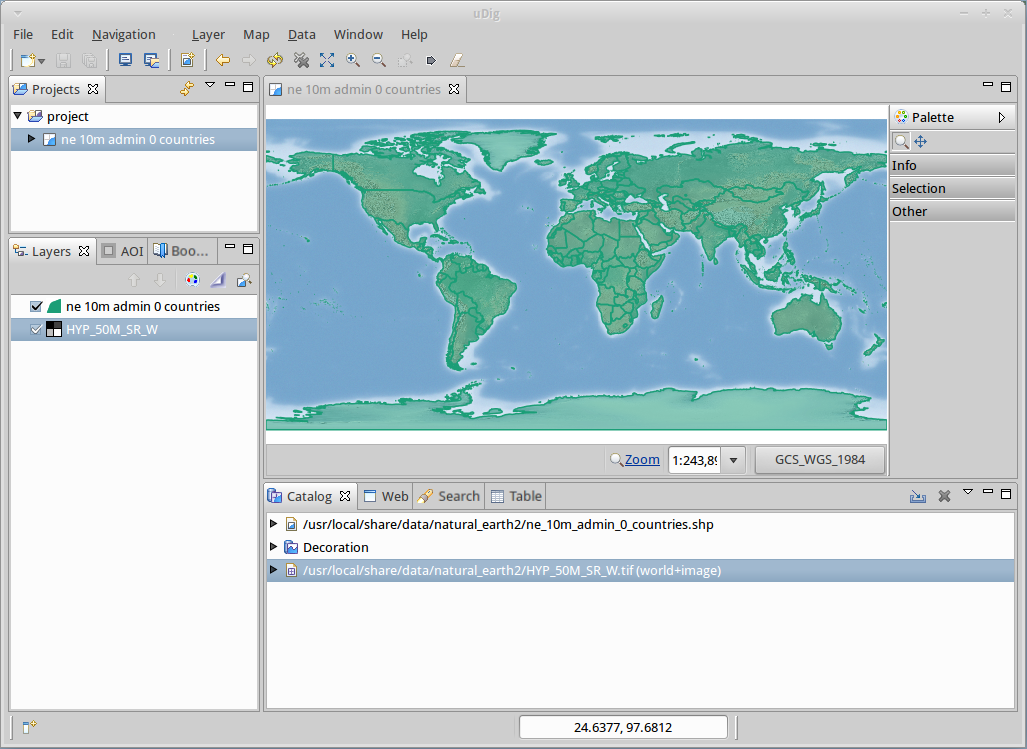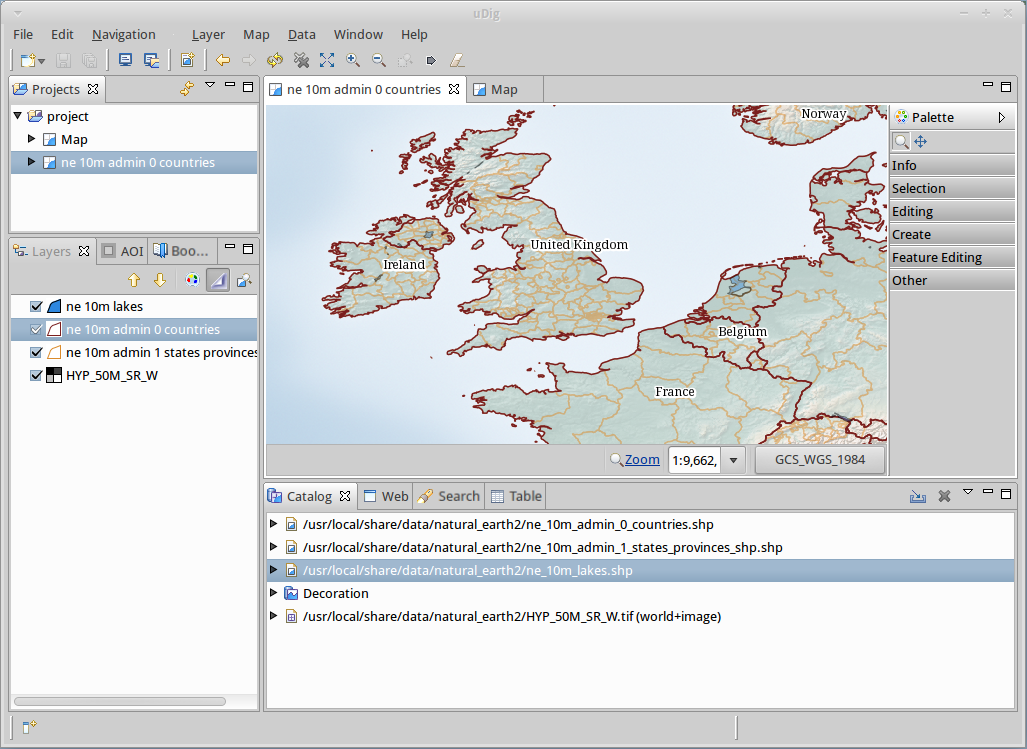
Muista
This project is only included on the OSGeoLive virtual machine disk (VMDK)
uDig Quickstart¶
uDig (User Friendly Internet Desktop GIS), is a GIS Desktop client for editing and viewing Geospatial data.
Tässä Pika-aloituksessa kuvataan, miten:
load a map layers from a shapefile and Web Map Service (WMS)
use the standard map tools
apply colour to map features using styling
Sisältö
start uDig¶
Choose from menu
The application will take a few moments to start up

If you have any difficulties, or are running uDig please review the Running uDig reference page.
Welcome View¶
When you start up uDig for the first time the Welcome view takes up the entire display. This screen has links to tutorials, documentation and the project website.
Click the arrow labelled Workbench in the upper right corner, to reveal the contents of the uDig workbench.
You can return to the Welcome view at any time by selecting the from the menu bar.
Workbench¶
The Workbench window offers multiple Editors (each showing a Map) and supporting Views (offering information about the current Map).
Shown above is a typical uDig session with the
Layers view (1),
Projects view (2),
Catalog view (3) and
Map editor (4).
These views will be described further as we demonstrate their use.
Files¶
To start out with we are going to load some of the sample data included on the DVD.
Choose from the menu bar to open up the Add Data wizard
Select Files from the list of data sources
Press Next to open up a file dialog
The OSGeoLive DVD contains sample data in:
~/data(a short cut to/usr/local/share/data)
Select the following file from the
natural_earth2folder:ne_10m_admin_0_countries.shp
Press Open
A new Map editor will be opened based on the contents of your shapefile. The default name and projection of the Map has been taken from your shapefile.
You can see the Catalog view has been updated with an entry for
ne_10m_admin_0_countries.shp. This view is used to track the use of resources by the uDig application.The Layers view shows a single layer is displayed on this map. This view is used to change the order and appearance of information in your Map.
The Projects view has been updated to show that your map is stored in projects > ne 10m admin 0 countries. You can have multiple projects open at a time, each project can have several maps.
Open up the
~/data/natural_earth2/folder on the desktopDrag
HYP_50M_SR_W.tifonto the Map Editor, a new layer is added to to the map.You can see the order the layers are drawn in the layer view. Right now the HYP_50M_SR_W layer is drawn on top of the ne 10m admin 0 countries layer.
Select the HYP_50M_SR_W layer in the catalog view and drag it to the bottom of the list
Muista
One of the most common questions asked when uDig is considered for an organization is how much memory the application uses. Unlike most GIS applications uDig can get by with a fixed amount of memory. The above shapefile is not loaded into memory, we have a policy of keeping data on disk and drawing data like this shapefile onto the screen as needed.
Vihje
You can also drag and drop shapefiles directly into the uDig application!
Map¶
You can control where in the world the Map Editor is looking by using the navigation tools in the tool bar along the top of the screen.
The
 Zoom tool is available by default
Zoom tool is available by defaultUse the zoom tool by drawing a box using the left mouse button around the area of the world you wish to see.
To zoom out draw a box with the right mouse button. The current map extents will be located within the box you draw.
The
 Pan tool can be used to scroll around your map with out changing scale.
Pan tool can be used to scroll around your map with out changing scale.There are also several navigation buttons that can be used at any time:
 Show All, can be used to return to the full extents at any time
Show All, can be used to return to the full extents at any time Zoom In and
Zoom In and  Zoom Out can be used to change the scale by a fixed amount.
Zoom Out can be used to change the scale by a fixed amount.You can use Navigation Back
 and Forward
and Forward  in the menu bar to cycle though previously
visited locations.
in the menu bar to cycle though previously
visited locations.
Vihje
Most tools allow you to Pan by holding the center button and control the scale using the scroll wheel.
Web Map Server¶
One of the reasons to use an application like uDig is to access all the great free geospatial information available on the web. This section covers the use of Web Map Servers which make available layers of information that you can mix into your own maps.
Muista
If you are not connected to the Internet run for a local WMS. The script will open a page with a ”Service Capabilities” section and two links for WMS Services you can drag into your empty map.
Vihje
You can copy a WMS URL (e.g. for WMS 1.1.1) from right panel of GeoServer Welcome page and ”paste” it either on the Map view or the Layers view. A wizard shows you the layers you can add to the Map. You can also connect to Web Map Servers using the Add Data () Wizard and paste WMS URL right there.
Select from the menu bar
Change to the Web view, click on the tab next to the Catalog view to reveal the Web view.
Click on the link
WMS\:http://www2.dmsolutions.ca/cgi-bin/mswms_gmap?Service=WMS&VERSION=1.1.0&REQUEST=GetCapabilities
From the Resource Selection page we are going to choose the following layers:
Elevation/Bathymetry
Parks
Cities
Press Finish to add these layers to your map
Use the
 Zoom Tool to move closer to one of the Parks
Zoom Tool to move closer to one of the ParksSwitch to the
 Info Tool and click on one the parks to learn more about it
Info Tool and click on one the parks to learn more about it
Vihje
You can switch between the zoom and info tools by pressing Z and I on the keyboard.
Style¶
Select the project > ne 10m admin 0 countries, you can double click to open this Map, or Right Click and choose Open Map
Select the countries layer in the Layer view
Open up the Style Editor by right clicking on ne 10m admin 0 countries layer and choosing Change Style
We are going to change a few things about how countries are displayed
Line: Click Border, click on the Color button and change the color to BLACK
Fill: On Tab Fill uncheck the box enable/disable fill to turn off fill
Label: On Tab Labels check the box enable/disable labeling, and choose the attribute NAME from the list of attributes

Press Apply to see what this looks like on your Map, the Layer view will also be updated to reflect the current style
When you are happy with the result you can press Close to dismiss the dialog
Muista
Some files include style settings. The Style definition can be found in files with the *.sld extension. The name itself should be equal to the file containing the data. If such a Styled Layer Descriptor (SLD) file exists, the style will be applied automatically.
Sometimes it is a bit hard to see what is going on with layer providing much details. To get focused on the task you like to work on, you can choose from the menu bar. Using the Layer view select different layers in turn to see the effect. You can turn off this effect at any time using from the menu bar.
Kokeiltavia asioita¶
Seuraavassa on joitakin muita haasteita, joita voit kokeilla:
Try viewing your own GIS map layers, or try adding a layer from a Web Feature Service (WFS)
Try styling the WFS layer.
Mitä seuraavaksi?¶
This is only the first step on the road to using uDig. There is a lot more great material (and ability) left for you to discover in our walkthrough documents.
Walkthrough 1
Try out the use of PostGIS, extract data from a Web Feature Server and explore the use of Themes with our powerful Color Brewer technology.
/usr/local/share/udig/udig-docs/uDigWalkthrough 1.pdfWalkthrough 2 - Learn how to create shapefiles and use the Edit tools to manipulate feature data, covers the installation of GeoServer and editing with a Web Feature Server.
Available on http://udig.refractions.net/







